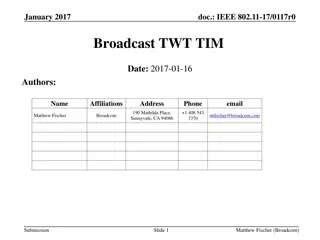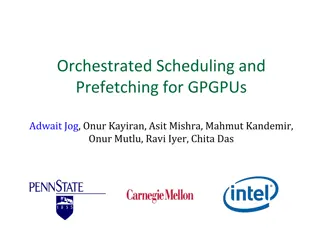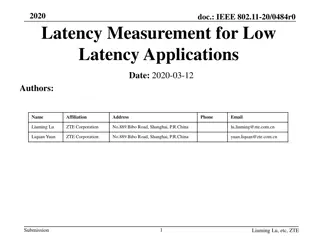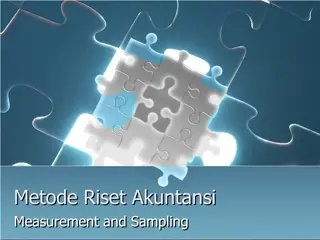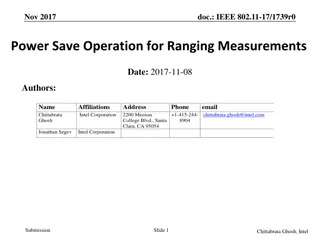Power-Efficient Scheduling for MU Measurement in IEEE 802.11-17
In this presentation related to IEEE 802.11-17, a power-efficient scheduling mechanism is proposed for power save STAs aiming to perform 11az-based measurements. The focus is on maximizing efficiency through NDP-based sounding mechanisms, UL and DL soundings, resource allocation, polling phases, wake times, and more within a TXOP framework to enhance overall performance.
Download Presentation

Please find below an Image/Link to download the presentation.
The content on the website is provided AS IS for your information and personal use only. It may not be sold, licensed, or shared on other websites without obtaining consent from the author. Download presentation by click this link. If you encounter any issues during the download, it is possible that the publisher has removed the file from their server.
E N D
Presentation Transcript
July 2017 doc.: IEEE 802.11-17/1128r0 Target Wake Time for MU Measurement Scheduling Date: 2017-07-12 Authors: Name Chittabrata Ghosh Affiliations Intel Corporation Address 2200 Mission College Blvd., Santa Clara, CA 95054 Phone +1-415-244- 8904 email chittabrata.ghosh@intel.com Jonathan Segev Intel Corporation Submission Slide 1 Chittabrata Ghosh, Intel
July 2017 doc.: IEEE 802.11-17/1128r0 Abstract In this presentation, we propose a power efficient scheduling mechanism for power save STAs that intend to perform 11az-based measurement Submission Slide 2 Chittabrata Ghosh, Intel
July 2017 doc.: IEEE 802.11-17/1128r0 Introduction The 11az amendment has agreed on using NDP-based sounding mechanism for measurement in the measurement phase Within a single TXOP, the UL sounding is followed by the DL sounding In UL sounding, UL NDPs are solicited from STAs assigned resources identified in the Trigger frame However, for efficient resource allocation, the AP needs to identify the STAs that intend to perform measurements We have agreed to have a polling phase prior to the MU measurement phase Slide 3 Submission Chittabrata Ghosh, Intel
July 2017 doc.: IEEE 802.11-17/1128r0 Illustration of a Single Polling Phase with Multiple NDP-based Measurement Phases TXoP Measureme nt Polling (e.g., BSRP) UL Sounding and DL Sounding for second set of STAs UL Sounding and DL Sounding for first set of STAs MU LMR Feedback Sequence (TBD) SIFS SIFS TBD (6 STAs have resource allocation for measurement ) (Assume 10% polling success) [14 STAs respond for measurement request] (8 STAs have resource allocation for measurement ) (14 STAs respond with LMR feedback) (Doze time for 8 STAs) (First wake-time for 14 STAs) (Doze time for 6 other STAs) (Wake-time for 6 other STAs) (On-channel availability for 14 STAs) For each measurement polling, a STA receives one allocation in a single Trigger frame of the MU measurement phase within a TXOP Submission Slide 4 Chittabrata Ghosh, Intel
July 2017 doc.: IEEE 802.11-17/1128r0 Individual TWT-enabled Periodic Measurement Phase TWT SP TWT SP TWT Negotiation Measur ement Polling TWT Request Measu rement Phase( s) Meas ureme nt Phase (s) Measu rement Polling TWT Response ACK ACK SIFS TWT Interval TWT Interval Each STA negotiates TWT for ranging with the AP STAs need not wake up to receive Beacon frames Number of measurement phases within a TWT SP is dependent on number of STAs responded to polling Polling is always the first phase within a TWT SP Submission Slide 5 Chittabrata Ghosh, Intel
July 2017 doc.: IEEE 802.11-17/1128r0 Broadcast TWT-enabled Dynamic Measurement Phases TWT 2 indicated in TWT 2 within Beacon TWT SP 2 TWT SP 1 TWT Negotiation Measur ement Polling LMR Feedb ack TWT Request Measu rement Phase( s) TWT Response Beacon ACK ACK TWT 1indicated in TWT 1 within Beacon Each STA participating in Broadcast TWT wakes up in pre-defined Beacon intervals to decode the TWT Element within the Beacon frame Each TWT Element contains the TWT of SP scheduled either for MU ranging or for measurement feedback report Number of measurement phases within a TWT SP is dependent on number of STAs responded to polling Polling is always the first phase within a TWT SP Submission Slide 6 Chittabrata Ghosh, Intel
July 2017 doc.: IEEE 802.11-17/1128r0 TWT Element Format and Control Field defined in 11ah, Reused in 11ax Submission Slide 7 Chittabrata Ghosh, Intel
July 2017 doc.: IEEE 802.11-17/1128r0 MU NDP Ranging Parameters We agreed that the MU NDP Ranging measurement opportunities scheduling will be signaled by the following parameters: Start time the TSF value at the beginning of the first Service Period. Ranging interval the time interval between two consecutive Service Periods. Measurement duration the time duration of the Service Period. If using TWT element for signaling the above parameters for MU NDP ranging measurements: Start time: This value is indicated by the Target Wake Time field that indicates the TSF time for the STA to initiate MU ranging negotiation Ranging interval: The difference between 2 start times provides the ranging interval Measurement duration: This value is indicated by the TWT Wake Interval Mantissa field and TWT Wake Interval Exponent subfield in Request Type field Interval = TWT Wake Interval Mantissa x 2^(TWT Wake Interval Exponent) Submission Slide 8 Chittabrata Ghosh, Intel
July 2017 doc.: IEEE 802.11-17/1128r0 Proposed TWT Element Format and Control Field for MU Ranging Reserved Ranging Bits 1 3 Ranging (B5) This subfield indicates that the signaling using the following fields in the TWT element are used for 11az-based ranging Submission Slide 9 Chittabrata Ghosh, Intel
July 2017 doc.: IEEE 802.11-17/1128r0 Summary In this presentation, we have introduced the TWT element as defined in 802.11ax We have proposed use of the TWT element for MU NDP measurement and in definition of the ranging start time, interval, and measurement duration Finally, we have proposed a differentiation of the TWT element to be used for MU NDP ranging over that in 802.11ax by using the following signaling: Ranging subfield in Control field Submission Slide 10 Chittabrata Ghosh, Intel
July 2017 doc.: IEEE 802.11-17/1128r0 Straw Poll Do you agree that the periodic MU measurements shall be based on Individual Target Wake Time (TWT) Y: N: A: Submission Slide 11 Chittabrata Ghosh, Intel
















